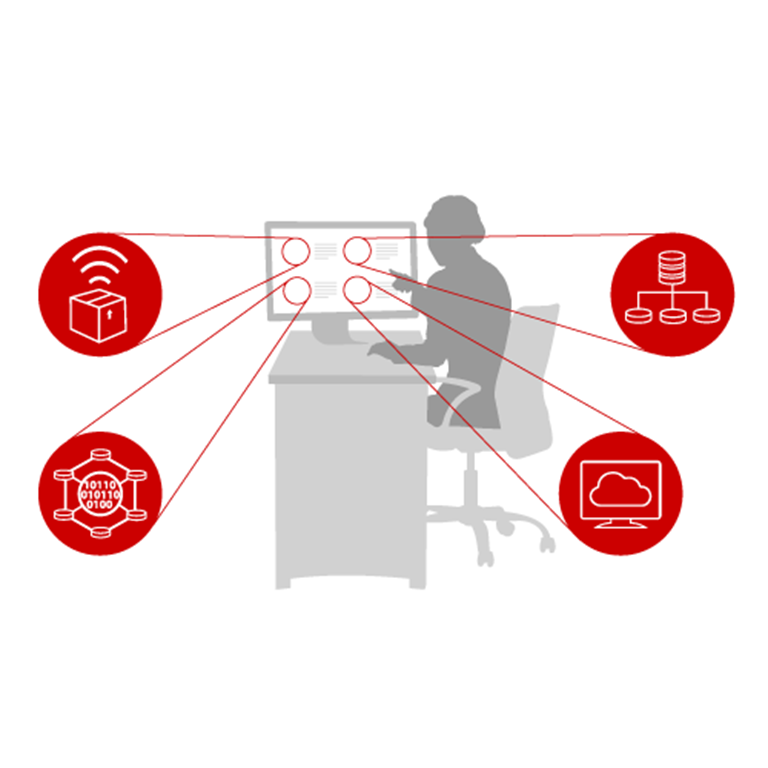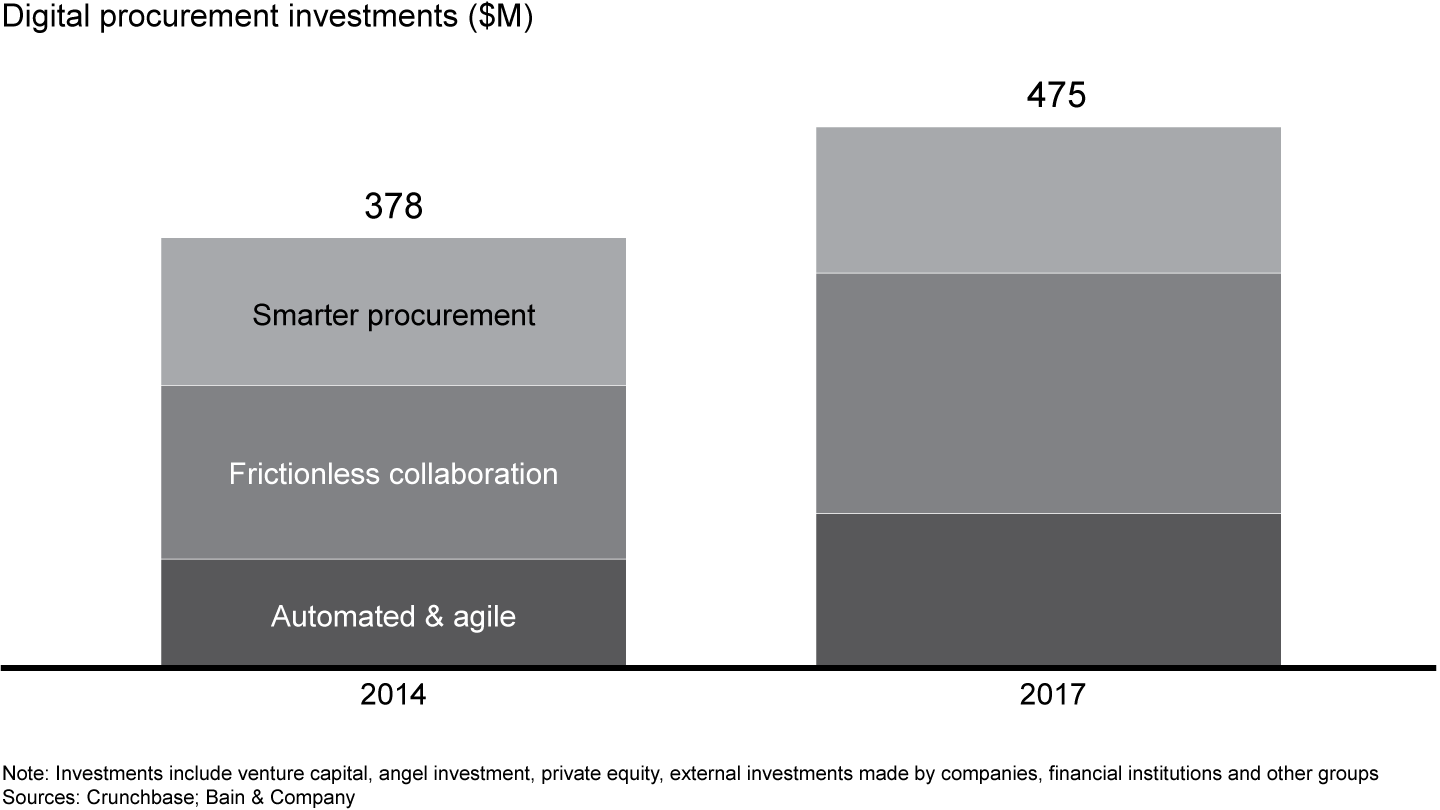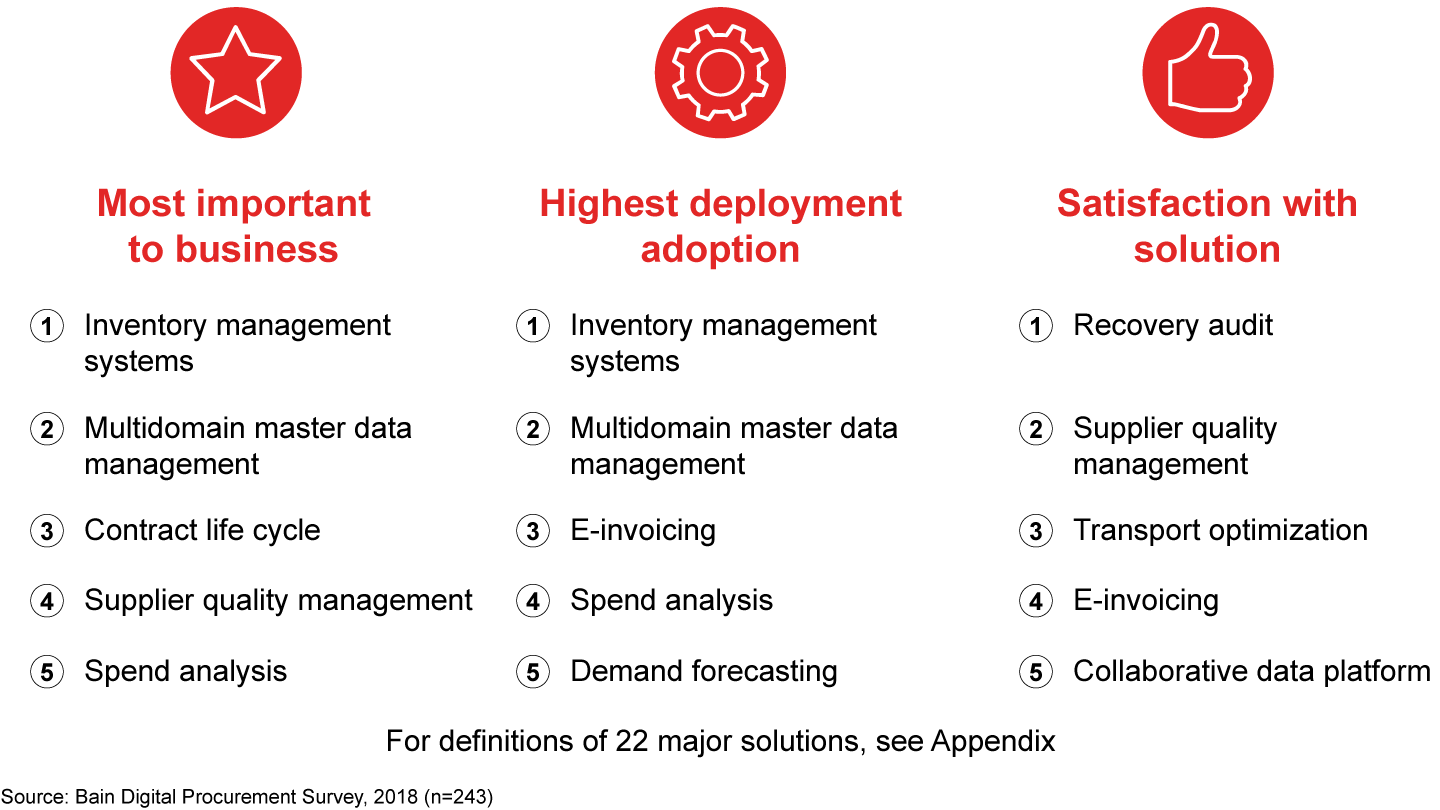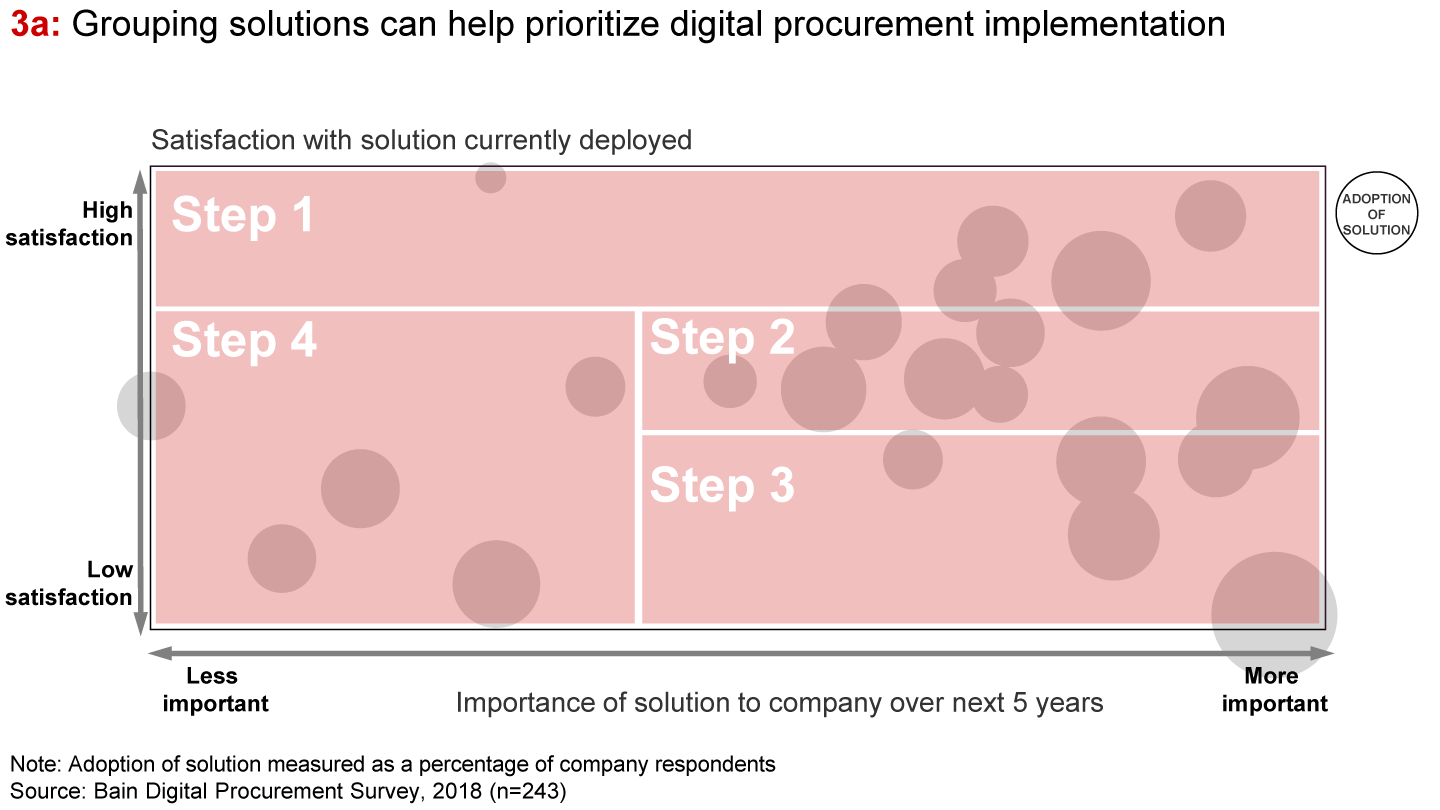Brief

In evidenza
- Digital procurement solutions not only create an opportunity to improve efficiency; they also pave the way for procurement teams to play a strategic role in accelerating innovation.
- Bain research highlights users’ ratings of 22 digital solutions based on satisfaction and importance.
- Automating purchasing processes frees resources for more strategic work, such as agile partnerships to help implement the company’s digital vision.
After months of making her case, the chief procurement officer (CPO) of a major multinational walked out of the executive team meeting with a big win—approval for a customized manufacturing process to help speed a new product to market. Her procurement team not only identified the emerging technology, it developed an innovative partnership agreement with two suppliers to codevelop it.
It all began six months earlier, when a business unit leader invited the CPO to brainstorm with his team on how to get a new product to market rapidly. The CPO knew two suppliers, one of which was breaking ground on an innovative production process for rapid prototyping and another using advanced analytics to accelerate design. She proposed codeveloping a customized manufacturing solution with the two suppliers. Procurement would orchestrate an agile team to test the process and, if successful, make the case for investing in the new technique. The business unit leader was thrilled.
Leaving the meeting, the CPO mused that five years before, she wouldn’t have even known about the suppliers’ innovations—or dared to propose that her team help develop a customized manufacturing solution. Most of procurement’s time back then was taken up with tactical activities and buying products that the business units ordered. The rapid emergence of shared data platforms and emerging technologies created an opportunity for procurement to speed innovation.
That scenario, though fictitious, is likely to become increasingly common in the 2020s as digital technologies pave the way for procurement teams to play a larger strategic role accelerating business innovation. Leading companies already are using digital tools to transform the way their procurement teams work. Artificial intelligence and robotic process automation are automating manual tasks and freeing up time for more strategic activities. Some CPOs have begun supporting business innovation and helping implement the company’s broader digital goals.
The economic and strategic benefits of digitizing procurement are real, but the proliferation of competing technologies has made it difficult for companies to figure out where to start. Bain & Company research has identified 22 digital procurement solutions, highlighting an increasingly complex environment.

How Digital Tools Are Transforming Procurement
Use a deep understanding of digital and the supply market to harness powerful insights.
That’s one reason many companies have only just begun experimenting with digital tools. Fewer than 10% of companies have deployed procurement solutions based on key technologies such as Big Data, the Internet of Things, serverless architecture or blockchain technology, Procurement Leaders’ research shows. For workflow assignment and supplier relationship management (SRM), more than 60% have no tools or rely primarily on improvised systems using Microsoft Office. For risk management, stakeholder management, category management and information sharing, that figure rises to more than 70%. Unlike cloud-based technologies, traditional Microsoft Office tools don’t allow real-time collaboration.
That’s a missed opportunity in cost savings and competitiveness. Research conducted by Procurement Leaders shows that a fully automated procurement function could save the Global 5000 up to $86 billion annually. For companies with a spending base of $1 billion to $3 billion, that implies $12 million in annual procurement headcount savings. Those that spend $3 billion or more would save an average $27 million on headcount.1
Digital technologies also provide a competitive edge by improving the speed and quality of procurement, reducing risk and enhancing innovation. As supply chains go global, they have become increasingly complicated and integrated, and the lines between suppliers, partners and customers are blurring. Companies that harness new tools to enhance collaboration with all those stakeholders will improve their speed and agility, reducing the time from purchase order to invoice. Automating purchasing processes, in turn, will decrease the amount of time procurement teams spend getting invoices paid and free up time for more strategic work, such as identifying smaller, innovative suppliers. Those that wait to digitize procurement risk being outmaneuvered by more agile rivals.
Successful companies wield deep understanding of the supply market and digital technologies to create powerful insights. Their procurement teams harness supplier innovation and take the lead in digital experimentation across the organization or the development of new solutions, such as the custom manufacturing process described above.
This report explores how digital tools can increase the efficiency and effectiveness of procurement and, importantly, how procurement can play a more strategic role in accelerating innovation and contributing to the company’s broader digital direction. We conclude with a few practical steps for creating a digital strategy and roadmap.
I. Improving procurement efficiency and effectiveness
Companies have been slow to embrace digital technologies within procurement for several reasons. Many have had a bad first experience implementing digital solutions. For others, the return on investment (ROI) isn’t clear, or the executive team doesn’t understand why procurement should be a strategic priority for information technology investments. As a result, those in charge of the company’s IT roadmap often deprioritize procurement solutions.
But the business case for digital procurement has become increasingly clear as companies gain experience with these technologies and track their performance. And the pace of change is accelerating. One key signal is the amount of capital investors are pouring into the development of digital procurement tools, betting they will produce significant value. Global investment in digital procurement including venture capital, private equity and other forms of investment totaled $475 million in 2017, up from $378 million in 2014 (see Figure 1). The growth in funding and low barriers to entry have contributed to a proliferation of new technologies on the market.

Procurement executives can start to assess the opportunity these technologies offer by understanding how they support three broad areas of change: automated processes, frictionless collaboration with suppliers and other stakeholders, and smarter procurement based on richer data sets.
Automated and agile operations. Artificial intelligence and robotic process automation (RPA) are transforming a critical range of procurement activities including spend analysis and procure-to-pay (P2P). These tools improve efficiency, accelerate processes and reduce errors. IBM, for instance, used RPA to resolve blocked invoices, reducing resolution time to 90 seconds, on average, from 32 minutes previously. At the same time, manual intervention to resolve blocked invoices dropped 95%. The new tools improved quality, oversight and traceability throughout the entire transaction.
The effort was part of a broader IBM initiative to automate every procurement process possible. To speed results, it encouraged employees to automate a process and sent them to a one-week “bot camp” where nontechnical staff could learn how to create simple bots to automate work. One procurement team member created a bot that reduced the time to create a savings report from three days to three hours, freeing up his time for more strategic activities.
Frictionless collaboration. New technologies have paved the way for collaboration platforms, real-time data collection, predictive analytics and blockchain. These tools allow procurement teams to easily share data and help cross-functional teams codevelop solutions with suppliers and internal stakeholders. Frictionless collaboration accelerates cycle times by improving internal coordination and supplier performance. Leading companies already are harnessing these technologies to speed problem solving and generate greater value for the business.
Take the example of a global industrial company that was struggling to achieve its procurement cost-savings targets because key managers disagreed about the data. Procurement insisted it had delivered the bulk of the promised savings, but they weren’t visible on the business unit profit and loss statement. The business unit leader explained that he hadn’t purchased as much as planned. Meanwhile, the CFO had made adjustments to the budget that altered targets. The problem was that all three parties lacked access to all the relevant data. Without a single source of truth, no one could make a clear case for how much the company had saved, or not saved.
To establish a definitive data source, the company implemented a collaborative data platform that included contract records, savings opportunities and methodology, key metrics and analysis, and stakeholder signoff. The platform became the single source of truth for all procurement data and included quick access to all business units and functions. That paved the way for transparent and aligned decision making on budget processes and eliminated chronic discord about the total savings hitting the bottom line.
Smarter procurement. Leading companies use digital tools for advanced category management, better sourcing strategies and improved forecasting. The building blocks are richer data sets, optimization engines, and tools to control demand and enforce compliance. Advanced category strategies help procurement teams reduce costs by buying better and spending better.
One global technology hardware manufacturer with more than $30 billion in sales had a problem with design engineers choosing parts independently for future products. Instead of asking the procurement team for a list of suppliers vetted for quality and price, some asked their cohorts for suggestions and others chose products after searching online. By the time the company was ready to build the product, it was far too late to consider an alternative part and the company was forced into a weak negotiating position.
To avoid that dilemma, the company deployed a procurement tool that embedded a catalog of preselected parts in the CAD software its engineers were using to design new products. The tool allowed engineers to select parts with prenegotiated rates, lead times and volume availability. If a part was not available in the approved parts catalog, the engineer could propose a nonvetted part, and the procurement team would get an alert in plenty of time to determine the best supplier.
Getting started
As many procurement executives know, the stakes are high for getting a digital solution right the first time around. A failed deployment can dissuade leadership teams from further investments. Procurement executives can begin building a sound digital strategy by choosing two to four digital tools that have a proven track record in the market. A Bain survey of 243 procurement professionals rated 22 digital procurement solutions and ranked them by their proven success in the market and importance in the coming five years (see Figure 2). The tools that scored high on customer satisfaction, for example, include supplier quality management, e-invoicing, transport optimization and collaborative data platform (see Figures 3a and 3b). These are solutions that have a higher likelihood of successful deployment and can help build momentum for digitizing procurement.

The next logical step is choosing tools that rank high in importance for the organization and relatively high in satisfaction. They include vendor management solutions (VMS) and multidomain master data management (see Figure 3c). These solutions also are likely to be successful and deliver a meaningful ROI, demonstrating the value of digitizing procurement.
The third cluster of tools includes those ranked high in importance but lower in satisfaction, largely because they are less mature or highly complex. That group includes contract life-cycle management, demand forecasting and network or market data intelligence (see Figure 3d). These solutions are riskier but still important for the organization, so proceed with caution and do proper due diligence to ensure you are selecting the right solution.
The fourth group rated low in satisfaction and low in importance—including dynamic discounting, e-auctions and social procurement tools (see Figure 3e). Companies should be highly selective and customize these tools or await market developments that boost their satisfaction and importance.

Successful companies not only choose their tools carefully, they prepare their organization to make the most of a new digital procurement solution before launching. Three criteria can help procurement executives determine which use cases will deliver the biggest impact for their company—and what they need to do to ensure a successful implementation.
Return on investment. It’s not uncommon for technology vendors to inflate the return on investment for any given software solution by including sizable indirect benefits, which may not require any technology investment at all. Procurement executives can come up with a more realistic estimate for return on investment by calculating the direct savings from the tool, indirect savings that can be achieved only with the tool in place, and any qualitative benefits such as error reduction or increased speed. A company’s business, location and the efficiency of its existing procurement operation, for example, will affect the potential return on investment. If a procurement department is located in a low-cost country, it may not make sense to automate certain functions.
Cross-functional capability, readiness and alignment. Many companies rush to deploy digital solutions without realizing their organization and partners are ill-prepared to make good use of them. Procurement executives can help ensure success by asking a few critical questions first: Do the people who will have to use the digital tools have the right skills—and will they adopt new solutions? Are finance teams tech savvy and willing to use new invoicing tools? Will supply chain staff embrace demand forecasting? A supplier management tool isn’t much use if the supplier continues to ask for a manual report. An honest assessment of how able different teams are to use digital solutions will help you focus on solutions that won’t hit a roadblock.
Technology requirements. Many companies make the mistake of assuming digital solutions need to be fully integrated into their existing enterprise resource planning (ERP) system. The good news is that often new tools can sit on top of most ERP systems without being formally integrated. That allows companies a more agile approach deploying best-of-breed tools. Of course, procurement teams should make sure that the company’s existing data system works well with new solutions. IT infrastructure shouldn’t limit functionality, and integration should be possible at a reasonable cost and within an acceptable time frame.

How Digital Tools Are Transforming Procurement
Use a deep understanding of digital and the supply market to harness powerful insights.
II. Enabling the company’s broader digital vision
While digital solutions make procurement processes far more efficient and effective than in the past, they also create a new range of strategic opportunities. In fact, many elements of a digital procurement strategy are important input to a firm’s digital roadmap. By helping accelerate innovation across the organization, procurement executives can play a vital role in shaping a company’s broader digital vision.
New suppliers and new ways of working, for example, are disrupting entire spending categories. A digitally savvy procurement team can enable companies to partner faster with innovative suppliers, embrace new ways of working and lead change. Digital procurement teams can also help companies rethink their operating model, partnerships, talent and culture—before rivals outmaneuver them.
Procuring solutions, not products
CPOs have an opportunity to start changing the nature of their conversations with business unit leaders by focusing on solutions rather than products. As procurement takes on this new role, business units will start coming to them with different questions. Problem statements such as “I need more rapid market intelligence to drive product innovation” or “I need better tracking of my products in the supply chain” will become the norm in the future, paving the way for procurement teams to offer innovative solutions.
For example, an industry consortium including ship builder Maersk is piloting a collaborative project to test the potential for using 3D printing as an alternative to storing thousands of spare parts on ships and in offshore facilities. 3D printing could reduce the space for parts storage and save on both cost and CO2 emissions. It might also offer real-time access to updated designs for ship systems. Ongoing maintenance, repair and overhaul traditionally have required companies to manage a massive inventory of replacement parts. The company’s procurement team is leading the project in the consortium including all the company’s major suppliers.
Marketing is another category of procurement spending that has been upended by technology. Twenty years ago, sales representatives purchased market reports to glean customer insights and predict future demand for a product. Today leading procurement teams are proposing innovative solutions to bring fresh market insights to companies faster than in the past: harness artificial intelligence and predictive analytics to build a dynamic in-house research capability that tracks customer demand in real time and speeds product innovation.
Procurement executives who seize the opportunity today to accelerate innovation will increase the strategic nature of their work and help bolster competitive advantage. But as external and internal stakeholders recognize that advantage, the practice is likely to become common practice, transforming the role of procurement.
Agile way of working
As companies face growing pressure to speed new products to market, agile procurement teams with deep knowledge about emerging technologies can help shrink development time by brokering collaborative relationships with innovative suppliers. Test-and-learn or innovation-based relationships will require procurement heads to work hand-in-hand with business unit leaders as well as a growing number of smaller vendors, including start-ups and sharing-economy platforms.
In that role, procurement teams will need to develop more flexible contracts that incorporate greater tolerance for risk. Companies pioneering collaborative supplier relationships use performance-based contracts to achieve a specific goal, like the new manufacturing technique described earlier. Another option is a contract incorporating a series of consecutive development goals with shorter defined sprints, a proof of concept or continuous releases. Additionally, large companies will need a new approach for dealing with promising companies that may not yet have a legal team.
Talent of the future
Leading companies are adding new talent to support a digital operating model. To develop sharp insights using digital tools, procurement teams will need data science and analytics expertise. Procurement executives are finding that it’s more effective to teach data scientists how to deploy that expertise into the procurement world than to teach data science and analytics to procurement professionals.
This talent profile is also increasingly entrepreneurial. Category strategies are changing more rapidly than in the past, and unless one remains proactive about understanding the latest technologies, vendors and competitive landscape, the company may fall behind.
Finally, procurement executives increasingly will act as stakeholder managers and orchestrate agile teams to operate across the business, increasing the need for collaborative skills. Working in Agile takes time to learn, but building this capability is increasingly becoming a strategic imperative for chief procurement officers across all industries.
III. Creating a procurement digital strategy and roadmap
For CPOs, making the most of the opportunities created by digital technologies can feel daunting. Leadership teams expect procurement teams to master these technologies and provide better service without increasing the cost of procurement. The good news: A digital procurement strategy can help reduce costs and free capacity for more strategic activities. That requires a clear roadmap. In this section, we highlight the three-step process procurement executives can use to start shaping a digital vision: Gather input; create a vision; and design a roadmap to get there.
Many procurement teams rush to create a digital strategy in a vacuum, often failing to achieve the intended benefits. To make sure a strategy is well designed, start by gathering information on digital trends from the company’s leadership, your industry, the market and procurement experts. What solutions and vendors are procurement executives in your industry adopting? What are the company’s digital goals and strategy? The answers to these questions provide critical context to identify the right digital procurement strategy.
The second step is creating the vision for procurement’s future role—say, three to five years from now. What processes should be digital and what solutions do you want to implement? Define how procurement will work with the business unit leaders and vendors to accelerate innovation and results. What kind of data, analytics, systems and technology do you need to support that role? What operating model and partnerships will you require?
The third step is a roadmap to implement the vision for a new role for procurement. Once the basic elements for a digital shift are in place, CPOs can set priorities including near-term goals that can create momentum for change, key investments, a detailed business case for the investment and a timeline.
Our research shows that 80% of procurement professionals believe they need to do more to take advantage of the latest digital tools. In our experience, leaders put a few basic elements in place to get the most from new solutions:
Clean, high-quality data. One data set becomes the single source of truth for all stakeholders.
Agile operating model. Clear roles, decision rights, governance and agile ways of working help procurement teams enter into strategic conversations with business unit heads and develop new supplier partnership models.
Digital and entrepreneurial talent. To support innovation more effectively, whether it is cocreating solutions, managing prototyping or speeding time to market, procurement teams of the future will need advanced digital skills and entrepreneurial ability.
Five years from now, CPOs may feel amazed about the increasingly strategic nature of their role—much as in our opening scenario. But not every company will make the transition. Procurement executives are standing at a crossroads today. They can either lead change by adopting digital solutions and developing new capabilities, or they can wait on the sidelines and react to a shifting landscape. And as a growing number of companies embrace digital procurement, those remaining on the sidelines will become less competitive.
Procurement professionals who are able to make this strategic shift will not just reap big gains in efficiency. They will lead in transforming the role of procurement and help enable a digital vision for the entire company.
1 Procurement Leaders’ data was in euros, and was converted to US dollars using the Internal Revenue Service’s 2017 exchange rate of $0.923 per euro.
Coleman Radell is a partner in Bain & Company’s Performance Improvement practice in the firm’s Los Angeles office. David Schannon is a partner in Bain’s Performance Improvement practice and is based in the company’s Silicon Valley office.
Select research provided by Procurement Leaders.


